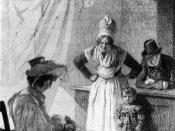Gustave Flaubert and Henrik Ibsen are both known as great writers and
harsh social critics. In fact when Flauberts masterpiece Madame Bovary was
released, he was arrested on the grounds that his novel was morally and
religiously offensive to the public, despite the fact that it was a bestseller. Also
Henrik Ibsens "A Doll's House" was such a slap in the face to many Europeans
that it was banned in some countries and revised in Germany so that it had a
happy ending. Some people in Norway even attributed the rising divorce rate to
this play! What is it that drove both of these authors to be such harsh social
critics? What exactly were their views? And what drove these two authors to
create two of their most famous characters: Nora, from "A Dolls House", and
Emma from Madame Bovary? An insight into the background of these authors
reveals that both Nora and Emma are reflections of social and political viewpoints
of their authors, and are at least partially based on people that the authors knew.
First of all, it is important to know the socio-economic status and
background of the two authors. It is also good to at least have an idea about the
society in which they lived. Then it is possible to see why they had certain
viewpoints and how these viewpoints had an effect on the personalities and
actions of their characters.
Gustave Flaubert was born on December 12, 1821 in Rouen, France to a
wealthy surgeon. As a boy he was well aware of the incompetence in the medical
profession, and the middle class "lip service" which he portrayed through Homais
in Madame Bovary. In his college years, Flaubert began to despise the middle
class even more as he became enthralled...


